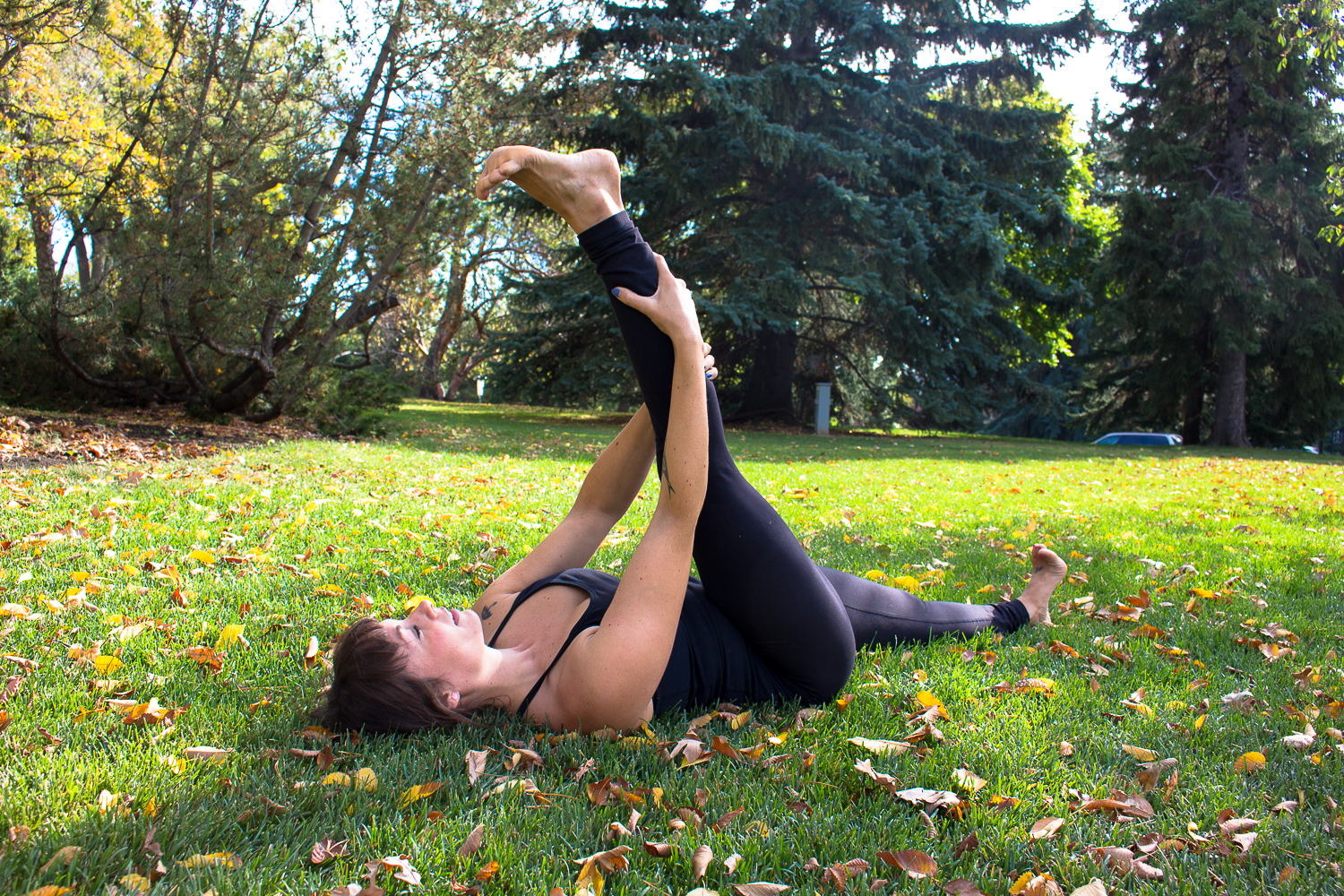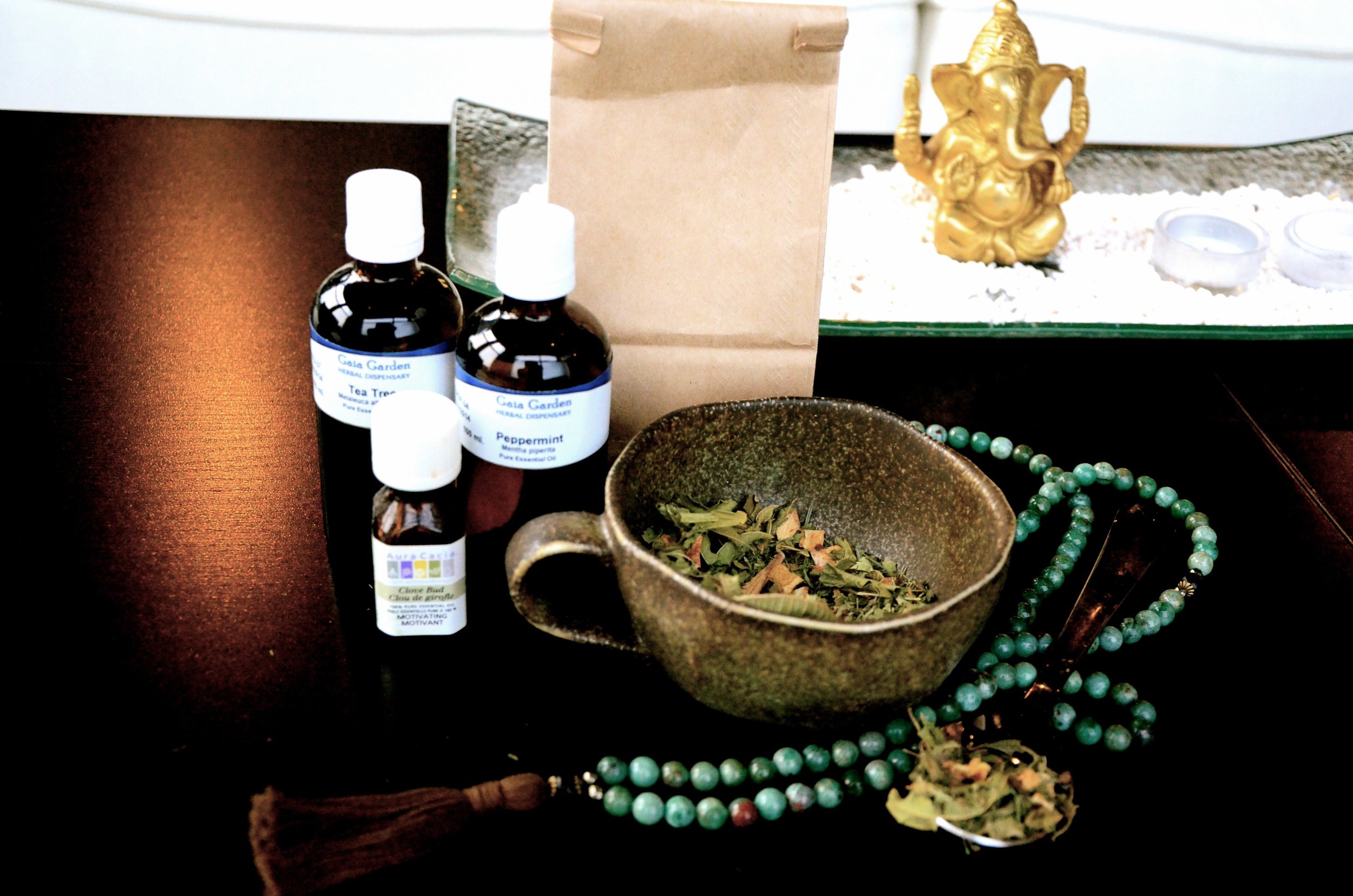Foundation Friday: Abhyanga
Our Foundation Friday series delves into the basics of yoga—looking at its postures (asana), breath (pranayama), philosophy, and all the other essentials—giving you the foundations upon which to build a solid practice. As this month is geared towards self-care, we are taking a look at the basics of Abyhyanga, or self massage, and sharing the foundations for you to give back to yourself.
Foundation Friday: Abhyanga
Abyhanga is the Indian tradition of self massage, done ritualistically to honour one's body as a temple. In India, this practice is done with babies until they grow old enough to do their own self massage and help the elders. Different oils are used for different doshas, the three human constitutions in the system of Ayurveda, or depending on climate and time of year. Sesame oil is the most common; be sure to opt for an organic, food-grade product as you are applying it to your largest organ. This Ayurvedic practice is traditionally performed in the morning, before your bath or shower, to facilitate the release of toxins that may have accumulated during the previous night. Self massage is perfect after dry skin brushing, another step in honouring your temple inside and out.
Benefits of Abhyanga
- Increased circulation, especially to nerve endings
- Toning of the muscles and the whole physiology
- Calming for the nerves
- Lubrication of the joints
- Increased mental alertness
- Improved elimination of impurities from the body
- Softer, smoother skin
- Increased levels of stamina through the day
- Better, deeper sleep at night
If you're interested in learning more about Ayurveda, we have an upcoming workshop at Yogalife Studios North An Ayurvedic Approach to Food Digestion & Cleansing with Ian Hayward November 1 || 11am-6:30pm
Ayurveda with Ian Hayward
Ayur = life, Veda = science or knowledge
Ayurveda is the traditional system of Hindu medicine that is rooted in the idea of balancing the body, mind and spirit to maintain health. The wisdom in this science of life is drawn from an understanding of the laws and rhythms of nature rhythms and laws, based around the five elements of ether, air, fire, water, and earth.
The following article comes to us from Ian Hayward. Ian was first introduced to Vedic knowledge in 1984 as he searched for alternatives to Western medicine to aid his health. He was initially instructed in the practice of Vedic mantra meditation. The profound effects of this effortless technique propelled him to learn more about this ancient health system. Over the next ten years Ian attended countless Meditation Retreats and Vedic Science Courses at home and abroad. He learned and regularly practiced Advanced Meditation Techniques including the Siddhi Yoga Sutras and eventually, in the summer of 1993, emerged from the Maharishi Vedic University in Valkenburg, Holland (Deepak Chopra’s training was in the same lineage) fully trained as a Panchakarma therapist offering an extensive range of bodyworks and elimination therapies and as an Ayurvedic Wellness Consultant offering pulse diagnosis and lifestyle solutions.
http://elementallifesolutions.com/pages/ian-hayward
Fall season is now well under way and this can be an excellent time to do a cleansing program. However any cleanse must be approached with a realistic attitude or the results could lead to a destabilization not just to the physical but to the mental & emotional levels as well. When you remove a physical toxin you also disturb the mental and emotional pattern that was involved in the forming of that toxin. This is why the experience of detoxification can be a roller coaster of thoughts and emotions.
Before you contemplate the level of detox you want to achieve take a realistic look at your present toxin level. If you are new to cleansing or have not been living a particularly pure lifestyle then you need to start gently. If you release too many toxins at once you can feel like you are being poisoned, this is disheartening, destabilizing and can set up a negative pattern towards purification. It is much more effective and positive experience to cleanse at a rate that leaves you feeling fresh and clean rather than sick and unstable.
It is also important to do a cleansing program that is right for your Elemental body type and dosha. Click here for more information and specific cleansing guidelines for different doshas.
Ian Hayward, Elemental Life Solutions Inc.
Join Ian at Yogalife Studios North on Saturday, October 18 from 11am to 6:30pm for 'Elemental Intro to Ayurveda', the first instalment of workshops geared towards building the key concepts of the Ayurvedic approach to health and wellness.
Register here and contact us (info@yogalifestudios.ca) with any questions!
Ayurveda
 Ayurveda is a Hindu system of traditional medicine native to India and a form of alternative medicine. It is found primarily as naturopathic and homeopathic medicine and is an ancient medical treatise on the art of healing and prolonging life.
Ayurveda is a Hindu system of traditional medicine native to India and a form of alternative medicine. It is found primarily as naturopathic and homeopathic medicine and is an ancient medical treatise on the art of healing and prolonging life.
In Sanskrit, ayur means life or living, and veda means knowledge, so Ayurveda has been defined as the "knowledge of living" or the "science of longevity."
Ayurvedic medicine utilizes diet, detoxification and purification techniques, herbal and mineral remedies, yoga, breathing exercises, meditation, and massage therapy as holistic healing methods. Ayurvedic medicine is known to be the oldest surviving healing system. According to the original texts, the goal of Ayurveda is prevention as well as promotion of the body's own capacity for maintenance and balance. Ayurvedic treatment is non-invasive and non-toxic, so it can be used safely as an alternative therapy or along-side conventional therapies. Ayurvedic physicians claim that their methods can also help stress-related, metabolic, and chronic conditions. Ayurveda has been used to treat acne, allergies, asthma, anxiety, arthritis, chronic fatigue syndrome, colds, colitis, constipation, depression, diabetes, flu, heart disease, hypertension, immune problems, inflammation, insomnia, nervous disorders, obesity, skin problems, and ulcers.
Ayurvedic physicians seek to discover the roots of a disease before it gets so advanced that more radical treatments are necessary.
Thus, Ayurveda seems to be limited in treating severely advanced conditions, traumatic injuries, acute pain, and conditions and injuries requiring invasive surgery. Ayurvedic techniques have also been used alongside chemotherapy and surgery to assist patients in recovery and healing. So, to understand Ayurvedic treatment, it is necessary to have an idea how the Ayurvedic system views the body. The basic life force in the body is prana, which is also found in the elements and is similar to the Chinese notion of chi. In Ayurveda, there are five basic elements that contain prana: earth, water, fire, air, and ether. These elements interact and are further organized in the human body as three main categories or basic physiological principles in the body that govern all bodily functions known as the doshas.
The three doshas are vata, pitta, and kapha. Each person has a unique blend of the three doshas, known as the person's prakriti, which is why Ayurvedic treatment is always individualized.
In Ayurveda, disease is viewed as a state of imbalance in one or more of a person's doshas, and an Ayurvedic physician strives to adjust and balance them, using a variety of techniques. The vata dosha is associated with air and ether, and in the body promotes movement and lightness. Vata people are generally thin and light physically, dry-skinned, and very energetic and mentally restless. When vata is out of balance, there are often nervous problems, hyperactivity, sleeplessness, lower back pains, and headaches. Pitta is associated with fire and water. In the body, it is responsible for metabolism and digestion. Pitta characteristics are medium-built bodies, fair skin, strong digestion, and good mental concentration. Pitta imbalances show up as anger and aggression and stress-related conditions like gastritis, ulcers, liver problems, and hypertension. The kapha dosha is associated with water and earth. People characterized as kapha are generally large or heavy with more oily complexions. They tend to be slow, calm, and peaceful. Kapha disorders manifest emotionally as greed and possessiveness, and physically as obesity, fatigue, bronchitis, and sinus problems.
Treatment:
Ayurvedic treatment seeks to re-establish balance and harmony in the body's systems. Usually the first method of treatment involves some sort of detoxification and cleansing of the body, in the belief that accumulated toxins must be removed before any other methods of treatment will be effective. After purification, Ayurvedic physicians use herbal and mineral remedies to balance the body as well. Ayurvedic medicine contains a vast knowledge of the use of herbs for specific health problems. Ayurvedic medicine also emphasizes how people live their lives from day to day, believing that proper lifestyles and routines accentuate balance, rest, diet, and prevention.
Ayurveda recommends yoga to build strength and health, and also advises massage therapy and self-massage as ways of increasing circulation and reducing stress. Yogic breathing techniques and meditation are also part of a healthy Ayurvedic regimen, to reduce stress and improve mental energy.
Of all treatments, though, diet is one of the most basic and widely used therapy in the Ayurvedic system. An Ayurvedic diet can be a very well planned and individualized regimen. According to Ayurveda, there are six basic tastes: sweet, sour, salty, pungent, bitter, and astringent. Certain tastes and foods can either calm or aggravate a particular dosha. For instance, sweet, sour, and salty decrease vata problems and increase kapha. Sour, salty, and pungent can increase pitta. After an Ayurvedic physician determines a person's dosha profile, they will recommend a specific diet to correct imbalances and increase health.
The Ayurvedic diet emphasizes primarily vegetarian foods of high quality and freshness, tailored to the season and time of day.
Cooling foods are eaten in the summer and heating ones in the winter, always within a person's dosha requirements. In daily routine, the heaviest meal of the day should be lunch, and dinner should eaten well before bedtime, to allow for complete digestion. Also, eating meals in a calm manner with proper chewing and state of mind is important, as is combining foods properly and avoiding overeating.
Whew! That is a lot of information, but now you know a great deal about Ayurveda, it's roots, treatments options, and how it applies to you and your life!
Categories
- Wellness 241
- Zen Habits & Inspiration 100
- Injury Prevention & Health 30
- Classes 1
- Yogalife Classes 7
- Prop Specific 1
- Studio Information 17
- Foundation Friday 25
- Physical Health 3
- Yoga Specific 54
- Curated Playlists 2
- Karma Program 5
- Staff Adventures & Journeys 10
- Anatomy & Information 30
- Community Event 15
- YEG Highlight 8
- Instructor Stories 22
- Yogi of the Month 13
- What's Going On 35
- Yogalife Workshops, Retreats & Trainings 37
- Recipe 10
- Relaxation 1
- Mental Health 2
- Workshops 34
- Registered Classes 4
- Pregnancy & Family 1
- Member Stories 5











